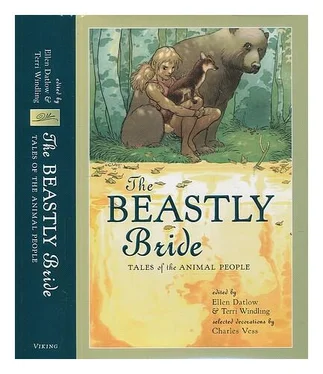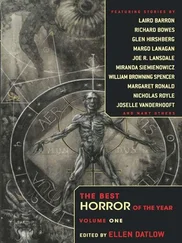Author’s Note
When The Beastly Bride tugged at my sleeve, I had been daydreaming about glass and its marvelous transformations. I thought immediately of a girl metamorphosed from the mythical fire-born salamander. Fiery and metamorphic glass led me to the furnace, the underworld, and a mix of earthly and otherworldly beauty.
The history of the Blue Ridge Mountains of North Carolina is one that includes magic and mythic beings. Tiny bones and small tunnels of the Little People had been found during construction in Cullowhee, where I grew up. Cherokee tales mixed in my mind with folk ways and stories handed down by settlers from Scotland and Ireland. Later, the magic of these regional tales tinged The Curse of the Raven Mocker and Ingledove and crept into some of my other novels, poems, and stories — as in this one.
THE MARGAY’S CHILDREN

Richard Bowes

PART ONE
Not to boast, but I’d say I’m pretty good as a godfather. As an actual parent, I’d doubtless have been a disaster. But I have six godchildren, and I love all of them. Selesta is the second eldest and my secret favorite. When she was real small, three and four years old, I had Mondays off and her mother, my friend Joan Mata, would leave her with me while she kept doctors’ appointments and met her design clients in the city.
That was when Selesta and I first talked about cats. At the time, I had an apartment on Second Avenue in the teens, and on the ground floor of the building facing mine was a row of small shops, each of which had a cat. Selesta took a great interest in them. That could just have been because she couldn’t have a cat of her own.
The Italian deli had a majestic tricolor cat named Maybelline. As a deli cat she had plenty of food, numerous admirers whom she would allow to pet her as she sat in the sun by the front door, and mice to keep her busy at night.
The Russian cobbler next door had a thin gray cat with a truncated tail that twitched back and forth. A shoe repair shop has no food and probably few mice. The cobbler was thin and gray himself, and when I once asked him the cat’s name he just shook his head, like he’d never heard of such a thing. So I decided to call him Hank, and Selesta agreed with me.
The third store was a Vietnamese nail and hair and massage shop with elaborate neon signage. It employed a trio of exotic ladies with elaborate nails, and one very silly man. Their cat was a Siamese named Mimi or something like that. Mimi had a wardrobe of exotic sweaters and collars and even booties.
She was usually carried by one of the ladies. When she passed by, the other cats’ noses and ears twitched, as if they could sense a cat nearby but couldn’t tell where it was.
To amuse ourselves, Selesta and I made up stories about the three cats and their adventures. Once they all went out to find a pair of red striped socks for Hank on his birthday. Another time they went to the moon, which was run by a bunch of gangster mice.
Maybe there I should have discouraged her interest. However, I believe Joan had asked me to be the godfather of her only child because we went back so far and shared so many secrets.
Eventually Selesta’s parents moved to Hoboken, New Jersey, she started school, and our Monday afternoons and the adventures of the store cats were no more.
It was a few years later, when she was eight or nine, that Selesta first asked me how her mother and I had become friends. It was the Wednesday after her birthday and I’d just taken her to see a matinee performance of Cats on Broadway. That had been her wish, and her mother had no objection.
The kick in taking a kid to the theater is seeing and sharing her unbridled wonder. Afterward we discussed the show and let the crowd carry us to the Times Square subway station. I noticed that Selesta now had her mother’s green eyes flecked with gold.
“My favorite part was the end where the cat goes up to heaven,” she said.
“On the old rubber tire,” I replied. “That’s the way it always happens with cats.”
“My mother says she has allergies so I can’t have a cat or dog.”
This sudden swerve in our conversation took me by surprise. “She is allergic, honey,” I said automatically and immediately regretted it. Kids are uncanny. Selesta knew I had lied, just as she suspected that her mother was lying.
She followed it up by saying, “Once when I was little you told me you and Mommy lived in a house with a mystery cat. Like Macavity in the show.”
Macavity, the villain of the musical, seemed to me too over-the-top to be very scary. The animal Selesta referred to had been very quiet and quite real.
“That was long before you were born or even thought of,” I said as the matinee crowds carried us down the subway stairs.
It bothered me that I had no recollection of ever having told her about the cat or about Anise’s Place on East Tenth Street. That was the semi-crash pad where her mother, Joan Mata, and
I first met back in those legendary times, the late 1960s.
“What was the cat’s name?”
By then we were waiting amid a crowd of commuters at 33rd Street for the PATH train to Hoboken. I began the story, and as I did, she listened with exactly the same rapt expression she’d had at the show.
“He was called Trebizon. That was an ancient city far away on the Black Sea. Anise, his owner, was a lady who had started to get a doctorate in history before she became a hippie and decided to let a bunch of people come live with her.”
“You and my mother were hippies!” The idea amused her.
“I guess I was. You’d have to ask your mother if she was.” Back then, my foothold in the city had been fragile. A stupid romantic quarrel, the kind a young man has at twenty-one, had put me out of the place where I’d been living and sent me crashing at Anise’s. But I didn’t go into that.
“What was Trebizon like?”
“He was a big old orange cat who seemed very smart.” I didn’t tell her that the people living in that neighborhood and in that apartment had achieved a really rarefied degree of psychic awareness and mind expansion. Apparently Trebizon shared this.
“It seemed he always had a favorite. When I first came to stay there, he spent every night on the chest of a very quiet stranger, a kid from the South who slept on the living room couch. Anise joked that the cat had adopted him.
“All of a sudden, every time a newcomer entered the apartment, the cat would get off his chest and sit and watch. The kid would take off all his clothes, kneel down on the floor in front of the new arrival, and kiss his or her feet.”
“He kissed your feet?” She was amused.
“It was creepy and embarrassing. But I noticed other people were pleased when it happened. Like they said to themselves, Finally, people are kissing my feet . I also saw that Trebizon acted like an owner whose pet had done a clever trick.
“I guess word got back to the kid’s family. Because one day his parents appeared and took him home.”
“What did Trebizon do?”
“Found someone else who lived there, a dreamy kind of girl who was studying to be a dancer. The cat slept beside her in this bed in a little alcove near the kitchen. We called her the Flower Girl because she brought home the single roses that gypsy ladies sold in bars and little sprays of lilies of the valley, potted geraniums.
Читать дальше















